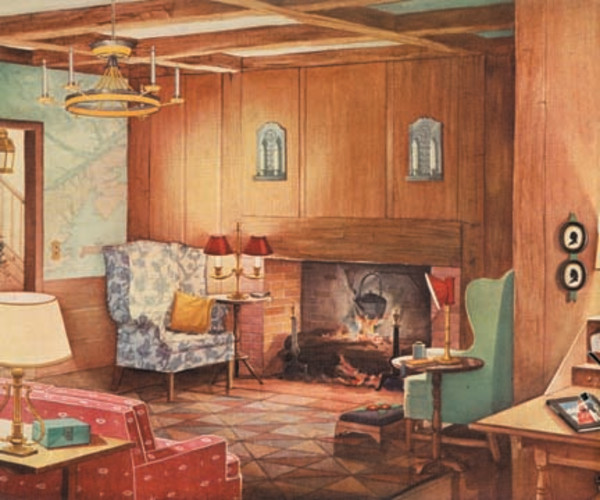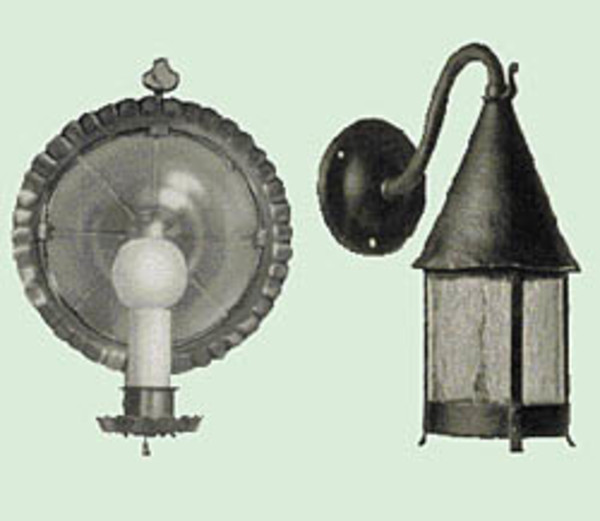
This Early American room from 1935 hits all the Romantic Revival lighting bases: hoop chandelier with scallop ornament, tin sconces, and shaded table lamps—all replete with electrified candles. (Images: Courtesy of American Life Foundation)
Ever wonder what turns us on about electric fixtures made for Romantic Revival houses built between the world wars, or what was called Early American, Colonial, English, and Spanish Manner? A 1920s illustration from Moe-Bridges lighting, featuring an old-looking house festively lit from within, provides the answer. The imagination and emotions evoked by this elegant romanticism rarely failed to captivate the eye back then or steal the heart even today.
What made Romantic Revival lighting intentionally old compared to other early 20th-century lighting? Consider the Arts & Crafts designers of the 1910s, who were among the first to enthusiastically embrace the flexibility of electric lighting—with its freedom from flame, heat, soot, and maintenance—for novel forms and locations. Though these designers sought to create new lighting by abstracting traditional shapes and eschewing applied ornament, they did pass on to Romantic Revival lighting the notion that fixtures should be sources of jewel-like pools of light in a room. In contrast, what made Art Deco and Art Moderne lighting new compared to “old” Romantic Revival lighting was not so much the fixtures but the way they bathed the entire room in light.
Romantic Revival fixtures can be divided into three categories: wall brackets or sconces, chandeliers, and lanterns. Of the three, wall brackets were the most delicate in design because the models for Romantic Revival lights were candle- powered; they were neither large nor large sources of light. Wall brackets also have the lowest survival rate. Because they made Romantic Revival walls look old-fashioned when styles changed, it was a small matter to unscrew the fixture, cap the wires, and patch the hole in the plaster prior to updating the paint scheme. They may still be hiding in the dark recesses of your attic.

Sconces took cues from colonial tinware and symbolic ornament; lanterns aped English medieval models.
Romantic Revival chandeliers, often appearing as either a black iron hoop suspended by chains or a spider of spindly metal arms, were sometimes victims of changing tastes. What they lacked was lux, failing to fulfill the contemporary concept of a chandelier as a ponderous cascade of prisms. Lanterns, on the other hand, have retained their appeal. Romantic Revival lanterns are typically more European medieval than oriental in design, with rectangular or cylindrical bodies and lids with functional-looking vents. Lanterns were deemed especially appropriate for creating an Early English look and could be located singly in hallways or as pairs flanking entrances or fireplaces.
Romantic Revival lighting manufacturers relied in part on the Victorian approach: using applied ornament as a legible shorthand for the historic styles of light fixtures. In the 1935 Chase Brass & Copper catalog, for example, the polished-brass Georgian fixtures have prisms and ornaments of shells, urns, leaves, fretwork, swags, and flame finials. Federal-style silver-plated fixtures have patriotic symbols, such as neoclassical urns, eagles, stars of the newly designed flag, and arrows from the Great Seal of the United States.
A more subtle legacy of Arts & Crafts designers was the idea that each historic style of light fixture had an appropriate signature metal. Although Chase Brass & Copper was in business to sell brass, it took this concept to heart with Early English fixtures that had brass cores encased by black iron. Brass also went into hiding with its Early American tin-plated sconces. Another aspect of Chase’s ornamental vocabulary was painted color options. Some of the back plates of the tin-plated Early American sconces and shades of table lamps were available in barn red, corn yellow, or laurel green.
That brings us to the sensitive matter of electric candles sporting little shades. Though obvious anachronisms (shades would burn on a candle), they were essential to Romantic Revival lighting because wall sconces and hanging chandeliers were originally designed for candles. Take away their candles and Romantic Revival fixtures lose their vital connection to the past. Besides, shades soften and scatter light. Our old-house ancestors were comfortable with them, so why not us?







